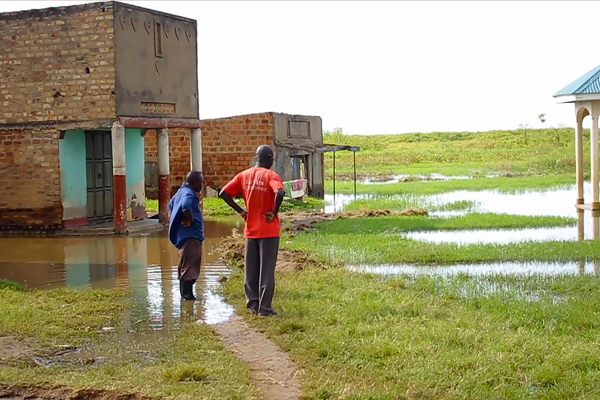Lake Kyoga bursts banks, displaces 5,000 families

Some of the homes that were submerged in Lwampanga Sub-county, Nakasongola District on Saturday. PHOTO/DAN WANDERA
What you need to know:
- Several houses, roads and gardens have been submerged
For the second consecutive year, Lake Kyoga has burst its banks following heavy rains, displacing more than 5,000 households in Nakasongola District.
The flood comes at a time when the district is struggling to relocate more than 850 households displaced from more than 10 landing sites in April 2020 after the lake burst its banks.
The district leaders told Daily Monitor on Monday that the floods have washed away roads, homes and gardens.
“We never anticipated the floods in some areas that are far from the lake shores. It is surprising that some of the affected areas have never experienced any form of flood threats. These people need emergency relief in terms of food and shelter,” Mr Sam Kigula, the Nakasongola District chairperson, said on Monday.
At Lwampanga Sub-county, the floods have submerged 20 houses including some of the buildings at Nakasongola Health Centre IV.
“Government should gain interest in helping the people in Nakasongola to identify safer areas to stay. It is unfortunate that the floods have struck at a time when the country is under a lockdown. The only lifeline for the displaced persons should be from government and well-wishers,” Mr Bernard Ssekyanzi Kirya, the Budyebo County Member of Parliament, said.
Some of the affected areas include Lwampanga Town Council, Zengebe, Moone, Kafu, Kikooge, Kansiri, Kabasombwe, Kitumba, Ninga, Kikoiro, Kibuye, Irima, Kyebisire, Kasambya and Munami villages.
Mr Charles Ssenabulya, a resident of Lwampanga Sub-county, said his gardens and the family house were destroyed by a flood last week.
“We sought refuge at a church located about 7kms from our former home. We were very confident that our location is safe since it is about 3kms from the Lake Kyoga shores. The new wave of floods has not spared us, luckily we did not lose any life,” he said.
In March, the Nakasongola District Local Government in partnership with the Office of the Prime Minister came up with a possible relocation plan for the people displaced by floods in April 2020 . According to the authorities, the families were to be relocated to the former Kyalubanga Forest Reserve land that had been degazetted by government for settlement and farming activity.
But the district officials on Monday revealed that the plan has been slowed down by the Covid-19 pandemic disruptions. “Relocation of a big population requires much planning and logistical support. As a district, we could not easily mobilise the resources. It is unfortunate that we now have another batch of the displaced persons in Nakasongola,” Mr Kigula said.
The district environment officer, Mr Charles Andama, complained that some of the affected residents have continuously refused to heed the advice to stay away from the buffer zones.
“The New National Environment Act 2019 limits the buffer zones for the lakes and rivers at 100 metres as minimum. It is clear that some of residents had decided to go back to their former settlements that had been affected by the floods in April 2020,” he said.
Mr Andama added: “Nakasongola is in the process of demarcating water and forest area buffer zones. The floods are a big setback to the affected communities as they negatively impact on their livelihoods. We need a permanent solution for the floods.”
Displaced
“We sought refuge at a church located about 7kms from our former home. We were very confident that our location is safe since it is about 3kms from the Lake Kyoga shores. The new wave of floods has not spared us, luckily we did not lose any life,” Mr Charles Ssenabulya, resident




